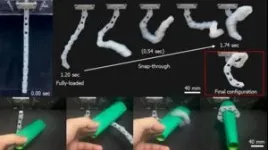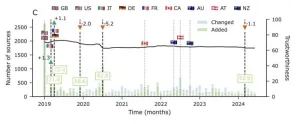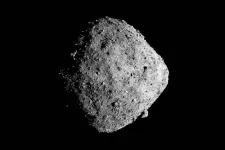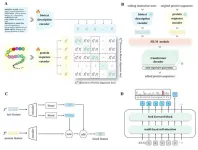(Press-News.org) When exercising in gyms, women face barriers across various domains, including physical appearance and body image, gym attire, the physical gym environment, and interactions with others, according to a study published January 29, 2025, in the open-access journal PLOS One by Emma Cowley from the SHE Research Centre, TUS, Ireland, and Jekaterina Schneider from the University of the West of England, U.K.
Exercise significantly improves physical, mental, and psychosocial health. Recent research indicates that women who engage in regular exercise experience greater health benefits than men, including lower incidence of all-cause mortality and reduced risk of cardiovascular events. Despite an increase in gym memberships, women are less active than men and little is known about the barriers women face when navigating gym spaces.
To fill this knowledge gap, Cowley and Schneider explored women’s body image and experiences exercising in gyms. Two-hundred and seventy-nine women (84% current gym-goers; 68.1% White) completed an online survey. The results showed that women often feel judged for their appearance and performance, leading to a persistent sense of inadequacy, as well as having to fight for space in the gym and to be taken seriously, while navigating harassment and unsolicited comments from men. Despite this, women showed signs of resistance toward gendered and appearance ideals permeating gym environments, and some experienced empowerment through skill acquisition, breaking gender norms, and exercising in supportive environments.
One key finding was women’s perceptions of gym attire as both a barrier and facilitator to exercise. Aligning with previous literature, women often chose attire based on comfort and functionality. However, their choices were also influenced by comparisons with others or fear of judgement for wearing non-branded attire or looking too put together. Many women also chose gym attire to hide perceived problem areas or avoid appearance concerns, including visible sweat stains.
According to the authors, the findings should be considered in light of several limitations. For example, most participants were White, heterosexual, identified as “normal” weight and able-bodied, were current gym-goers, and lived in western, educated, industrialized, rich, and democratic countries; this may limit the generalizability of these findings and further research should endeavor to diversify the sample population. Despite these caveats, the researchers propose a multi-level approach to support women in accessing and feeling comfortable in gym spaces, to increase physical activity and reduce exercise disengagement among this population.
The authors add: “In the gym, just like in other areas of life, women often feel stuck between being seen as ‘too much’ and ‘not enough’, dealing with judgement about how they look, how they perform, and even how much space they take up. Even though the pressure to be super thin is decreasing, the growing focus on being muscular and athletic is creating new challenges. It is pushing unrealistic standards that can negatively affect women’s body image and overall well-being.”
In your coverage, please use this URL to provide access to the freely available article in PLOS One: https://journals.plos.org/plosone/article?id=10.1371/journal.pone.0316756
Citation: Cowley ES, Schneider J (2025) “I sometimes feel like I can’t win!”: An exploratory mixed-methods study of women’s body image and experiences of exercising in gym settings. PLoS ONE 20(1): e0316756. https://doi.org/10.1371/journal.pone.0316756
Author countries: U.K., Ireland
Funding: The author(s) received no specific funding for this work.
END
Women exercising in gyms often face barriers including body image and harassment
Information could help create more inclusive gym spaces for women
2025-01-29
ELSE PRESS RELEASES FROM THIS DATE:
SNU researchers apply the principles of mantis shrimp and fleas to create soft robots with powerful movements
2025-01-29
Seoul National University College of Engineering announced that a research team led by Professor Kyu-Jin Cho (Director of the Soft Robotics Research Center) from the Department of Mechanical Engineering took inspiration from principles found in nature and developed the "Hyperelastic Torque Reversal Mechanism (HeTRM)," which enables robots made from rubber-like soft materials to perform rapid and powerful movements. This study was published in the prestigious international journal Science Robotics on January 29.
The mantis shrimp delivers a punch ...
Quantum-inspired computing drives major advance in simulating turbulence
2025-01-29
UNDER EMBARGO UNTIL 19:00 GMT / 14:00 ET, WEDNESDAY 29 JANUARY 2025
Quantum-inspired computing drives major advance in simulating turbulence
Researchers at the University of Oxford have pioneered a new approach to simulate turbulent systems, based on probabilities. The findings have been published today (29 January) in the journal Science Advances.
Predicting the dynamics of turbulent fluid flows has long been a central goal for scientists and engineers. Yet, even with modern computing technology, direct and accurate simulation of all but the simplest turbulent flows remains impossible.
This is due to turbulence being ...
New microscopy technique reveals dynamic Escherichia coli membrane stiffness
2025-01-29
Light and electron microscopy have distinct limitations. Light microscopy makes it difficult to resolve smaller and smaller features, and electron microscopy resolves small structures, but samples must be meticulously prepared, killing any live specimens.
Atomic force microscopy (AFM) is a technique originally developed to assess the physical and mechanical properties of materials at extremely high resolutions, but the imaging speeds aren’t fast enough (e.g. several minutes per frame) to capture relevant data for living biological samples. In contrast, another method, high-speed AFM (HS-AFM), is fast but cannot measure mechanical properties. Understanding ...
Bad hair bears! Greasy hair gives polar bears fur with anti-icing properties
2025-01-29
An international team of scientists has discovered the anti-icing secret of polar bear fur – something that allows one of the planet’s most iconic animals to survive and thrive in one of its most punishing climates. That secret? Greasy hair.
After some polar sleuthing, which involved scrutiny of hair collected from six polar bears in the wild, the scientists homed in on the hair “sebum” (or grease) as the all-important protectant. This sebum, which is made up of cholesterol, diacylglycerols, and fatty acids, makes it very hard for ice to attach to their fur.
While this finding ...
Materials can remember a sequence of events in an unexpected way
2025-01-29
UNIVERSITY PARK, Pa. — Many materials store information about what has happened to them in a sort of material memory, like wrinkles on a once crumpled piece of paper. Now, a team led by Penn State physicists has uncovered how, under specific conditions, some materials seemingly violate underlying mathematics to store memories about the sequence of previous deformations. According to the researchers, the method, described in a paper appearing today (Jan. 29) in the journal Science Advances, could inspire new ways to store information in ...
NewsGuard: Study finds no bias against conservative news outlets
2025-01-29
[Vienna, 29.01.2025]—A recent study evaluating the NewsGuard database, a leading media reliability rating service, has found no evidence supporting the allegation that NewsGuard is biased against conservative news outlets. Actually, the results suggest it’s unlikely that NewsGuard has an inherent bias in how it selects or rates right-leaning sources in the US, where trustworthiness is especially low.
“It seems unlikely that NewsGuard has an inherent bias against conservative sources, both in selecting and giving them lower ratings. Instead, the US media system is flooded with right-wing sources that tend to not adhere to professional ...
New tool can detect fast-spreading SARS-COV-2 variants before they take off
2025-01-29
By analysing millions of viral genome sequences from around the world, a team of scientists, led by the Peter Doherty Institute for Infection and Immunity (Doherty Institute) and the University of Pittsburgh, uncovered the specific mutations that give SARS-CoV-2 a ‘turbo boost’ in its ability to spread.
“Among thousands of SARS-CoV-2 mutations, we identified a small number that increase the virus’ ability to spread,” said Professor Matthew McKay, a Laboratory Head at the Doherty Institute and ARC Future Fellow in the Department of Electrical and Electronic Engineering at the University of Melbourne, and co-lead author of the ...
Berkeley Lab helps explore mysteries of Asteroid Bennu
2025-01-29
During the past year, there’s been an unusual set of samples at the Department of Energy’s Lawrence Berkeley National Laboratory (Berkeley Lab): material gathered from the 4.5-billion-year-old asteroid Bennu when it was roughly 200 million miles from Earth.
Berkeley Lab is one of more than 40 institutions investigating Bennu’s chemical makeup to better understand how our solar system and planets evolved. In a new study published today in the journal Nature, researchers found evidence that Bennu comes from an ancient wet world, with some material from the coldest regions of the solar system, likely beyond the orbit of ...
Princeton Chem discovers that common plastic pigment promotes depolymerization
2025-01-29
It turns out that the black plastic lid atop your coffee cup has a superpower. And the Stache Lab at Princeton Chemistry, which uncovered it, is exploiting that property to recycle at least two major types of plastic.
Their startling mechanism for promoting depolymerization relies on an additive that many plastics already contain: a pigment called carbon black that gives plastic its black color. Through a process called photothermal conversion, intense light is focused on plastic containing the pigment that jumpstarts the degradation.
So far, researchers have shown that carbon black can depolymerize polystyrene and polyvinyl chloride (PVC), two of the least recycled plastics in the planet’s ...
AI-driven multi-modal framework revolutionizes protein editing for scientific and medical breakthroughs
2025-01-29
Researchers from Zhejiang University and HKUST (Guangzhou) have developed a cutting-edge AI model, ProtET, that leverages multi-modal learning to enable controllable protein editing through text-based instructions. This innovative approach, published in Health Data Science, bridges the gap between biological language and protein sequence manipulation, enhancing functional protein design across domains like enzyme activity, stability, and antibody binding.
Proteins are the cornerstone of biological functions, and their precise modification holds immense potential for medical therapies, synthetic biology, and biotechnology. While traditional protein editing methods ...
LAST 30 PRESS RELEASES:
Chicago health information leader recognized for raising CPR readiness and blood pressure awareness
The Intimate Animal, a new book from Kinsey Institute Executive Director Dr. Justin Garcia
When blue-collar workers lose union protection, they try self-employment
New video dataset to advance AI for health care
MEA-based graph deviation network for early autism syndrome signatures in human forebrain organoids
New modeling approach sheds light on rare gut disease
Study documents potentially hazardous flame retardants in firefighter gear
Can certain bacteria regulate aging of the immune system and its related alterations?
AI model helps diagnose often undetected heart disease from simple EKG
There are fewer online trolls than people think
Cell membrane fluctuations produce electricity
Jeonbuk National University study shows positive parenting can protect adolescents against self-harm
Surface-engineered ZnO nanocrystals to tackle perfluoroalkyl substance contamination
This new understanding of T cell receptors may improve cancer immunotherapies
A new fossil face sheds light on early migrations of ancient human ancestor
A new immunotherapy approach could work for many types of cancer
A new way to diagnose deadly lung infections and save lives
40 percent of MRI signals do not correspond to actual brain activity
How brain-inspired algorithms could drive down AI energy costs
Gum disease may be linked to plaque buildup in arteries, higher risk of major CVD events
Contrails are a major driver of aviation’s climate impact
Structure of dopamine-releasing neurons relates to the type of circuits they form for smell-processing
Reducing social isolation protects the brain in later life
Keeping the heart healthy increases longevity even after cancer
Young adults commonly mix cannabis with nicotine and tobacco
Comprehensive review illuminates tau protein's dual nature in brain health, disease, and emerging psychiatric connections
Book prepares K-12 leaders for the next public health crisis
Storms in the Southern Ocean mitigates global warming
Seals on the move: Research reveals key data for offshore development and international ecology
Sports injuries sustained during your period might be more severe
[Press-News.org] Women exercising in gyms often face barriers including body image and harassmentInformation could help create more inclusive gym spaces for women










